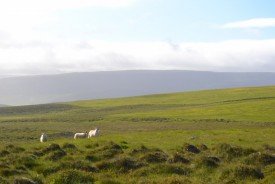New paper on sheep grazing and land degradation of Icelandic ecosystems
A new paper on sheep grazing and Icelandic ecosystems has been recently published in the journal Land Degradation & Development. The paper “The sheep in wolf’s clothing? Recognizing threats for land degradation in Iceland using state‐and‐transition models” is led by Isabel C Barrio, project manager at UNU-LRT and co-authored by several UNU-LRT lecturers. You can access the article here.
Many old stories include warnings to beware of nasty surprises that can appear harmless, like the wolf disguised as a sheep to better sneak up on the unknowing flock. But what if the sheep themselves are actually the nasty surprise? In some parts of Iceland, extensive land degradation has been linked to overgrazing by livestock, as well as land clearing and natural processes including a harsh climate and frequent volcanic activity. Identifying the factors responsible for ecosystem changes in these environments is essential for making good management decisions, especially because some of these drivers of change, like grazing practices, are easier to manipulate than others, such as climate change.
The paper develops at set of conceptual models to help organize existing knowledge about the factors influencing ecosystem changes in Iceland. The authors used state-and-transition models, a simple representation using boxes and arrows, to describe ecosystem changes over three periods with different human influence, from pre-settlement times to present days. Their models identify the set of possible states, transitions and thresholds in these ecosystems and their changes over the past 1,100 years. The results suggest increasing complexity in recent decades where the models include stronger human influences, particularly sheep grazing. To illustrate the use of these models to make predictions about possible management interventions, the authors also present a case study from Auðkúluheiði in the central highlands. This approach can help farmers, managers and researchers identify important knowledge gaps and inform conservation efforts and monitoring programmes, by identifying realistic and achievable restoration goals.
The conditions in Iceland, the severe land degradation and active restoration efforts are among the reasons for the location of the UN University Land Restoration Training Programme in Iceland. Publications like this one are valuable for teaching and research purposes at UNU-LRT.


